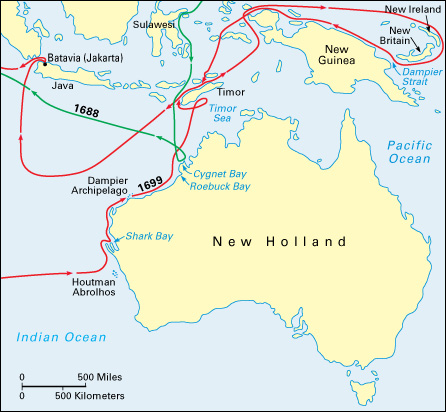Dampier << DAM pee uhr or DAMP yuhr >>, William (1651-1715), was an English explorer, pirate, and author. He visited Australia and the far South Pacific and wrote one of the first English accounts of the region. Dampier circumnavigated (sailed around) the globe three times during his career.


Dampier was born in 1651 in East Coker, Somerset, England. After being orphaned as a child, he became an apprentice to a shipmaster. Dampier served briefly in the Royal Navy in 1673. After leaving the Navy, he traveled to the Caribbean. There, he worked on a sugar plantation and as a logger. After a hurricane destroyed his logging camp, Dampier joined a group of pirates. The crew sailed around the coastal areas of Latin America, attacking ships and settlements. During this time, Dampier took notes on the local plants and wildlife that he saw.
Dampier first sailed around the globe from 1679 to 1691, on a journey that began as a piracy venture. He traveled on a series of ships with different crews. His journey took him south from England, west around the southern tip of South America, across the Pacific Ocean, around the southern tip of Africa, and north back to England, with various stops along the way. Dampier and his fellow crew members on the ship Cygnet became the first English people to visit the Australian mainland, then called New Holland. Dampier’s return to England in 1691 marked the third time an Englishman had sailed around the world. Sir Francis Drake led an English expedition that circumnavigated the globe from 1577 to 1580, and Thomas Cavendish led another from 1586 to 1588.
Dampier’s first book, A New Voyage Round the World, was published in 1697. It stimulated travel literature and English interest in the Pacific. Dampier also wrote a sequel, Voyages and Descriptions (1699). This book contained descriptions of trade winds in the Pacific Ocean that helped guide future generations of sailors.
From 1699 to 1701, Dampier led a scientific expedition to Australia financed by the English Admiralty. This voyage was one of the first scientific expeditions in history. Dampier sailed south from England, and then east around the southern tip of Africa, on the H.M.S. Roebuck. The ship landed on the western coast of Australia in August 1699. Dampier named the inlet where his ship anchored Shark Bay. While exploring the area, he collected plant samples to take back to England. After leaving Australia, he sailed around Timor and New Guinea. He also visited and named the island of New Britain, which lies off the northeast coast of New Guinea. Dampier returned home by sailing west around the Cape of Good Hope, and then north. In 1702, after returning to England, Dampier was court-martialed (tried by a military court) for mistreating one of his officers. He was found guilty and fined.
In 1703, Dampier became a privateer—that is, an independent sailor employed by a nation to assist it in time of war. During the War of the Spanish Succession (1701-1714), English privateers attacked Spanish merchant ships and sank or robbed them. As a privateer, Dampier circumnavigated the globe two more times, from 1703 to 1707, and again from 1708 to 1711. These journeys followed similar routes to Dampier’s first trip around the world. During this period, Dampier’s book A Voyage to New Holland was published in two volumes, in 1703 and 1709. Dampier returned to England in 1711. He died in London in 1715. Dampier’s books influenced many famous explorers and writers, including the British naval captain and navigator James Cook, the British naturalist Charles Darwin, and the English author Jonathan Swift.
